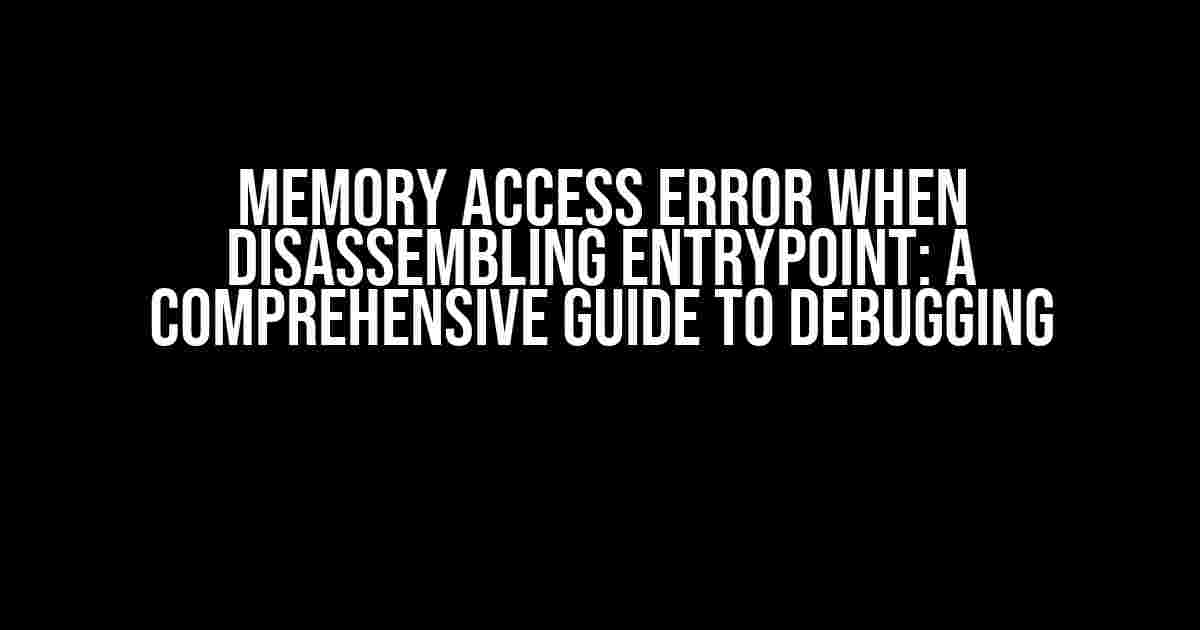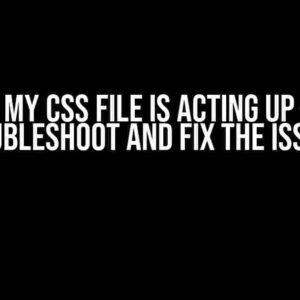Encountering a memory access error when disassembling the entry point can be a frustrating and daunting experience, especially for novice reverse engineers and programmers. In this article, we will delve into the common causes of this error, provide step-by-step instructions on how to identify and fix the issue, and offer tips on how to prevent it from happening in the future. Buckle up, and let’s dive into the world of debugging!
What is a Memory Access Error?
A memory access error occurs when a program attempts to access a memory location that is not allocated, protected, or is outside the bounds of an array. This can lead to a crash, freeze, or, in our case, a memory access error when disassembling the entry point. The entry point, also known as the program’s starting point, is where the program begins execution.
Common Causes of Memory Access Error
Null or uninitialized pointers: When a pointer is not properly initialized or is set to null, attempts to access the memory location it points to will result in an access error.Out-of-bounds array access: When an array is accessed with an index that is outside the bounds of the array, an access error occurs.Memory corruption or overwrite: When memory is corrupted or overlaid with new data, the program may attempt to access an invalid memory location.Incorrect or outdated library or API usage: Using an outdated or incorrect library or API can lead to memory access errors.Buffer overflow or underflow: When a buffer is overwritten or underwritten, memory access errors can occur.
Identifying the Memory Access Error
To identify the memory access error, follow these steps:
Run the program under a debugger: Use a debugger like OllyDbg, x64dbg, or IDA Pro to run the program and pause it at the entry point.Examine the disassembly: Look at the disassembly code and identify the instruction that causes the memory access error.Check the registers and memory: Inspect the registers and memory locations involved in the instruction to identify any suspicious values or patterns.Analyze the call stack: Examine the call stack to identify the function or module that called the entry point.
Example Disassembly Output
00401000 | 55 push ebp 00401001 | 8B EC mov ebp,esp 00401003 | 83 EC 10 sub esp,10 00401006 | 8B 45 FC mov eax,[ebp-4] 00401009 | 8B 40 04 mov eax,[eax+4] 0040100C | 8904 24 mov [esp],eax 0040100F | 8B 45 FC mov eax,[ebp-4] 00401012 | 8B 40 04 mov eax,[eax+4] 00401015 | 8944 24 04 mov [esp+4],eax 00401019 | 890C 24 mov [esp+8],ecx 0040101C | E8 00000000 call sub_401021 00401021 | 83 C4 10 add esp,10 00401024 | 5D pop ebp 00401025 | C3 ret
Fixing the Memory Access Error
To fix the memory access error, follow these steps:
Identify the root cause: Determine the root cause of the memory access error based on the analysis performed in the previous section.Fix the pointer or array access: Correct the pointer or array access that is causing the memory access error.Initialize or reinitialize variables: Ensure that all variables are properly initialized or reinitialized to prevent memory access errors.Verify library or API usage: Verify that the library or API is being used correctly and is up-to-date.Patch or update the program: Apply patches or updates to the program to fix any known issues or bugs.
Common Fixes for Memory Access Errors
| Error Type | Fix |
|---|---|
| Null pointer dereference | Initialize the pointer to a valid memory location or check for null before accessing it. |
| Out-of-bounds array access | Verify the array bounds and ensure that the index is within the valid range. |
| Memory corruption or overwrite | Identify and fix the root cause of the memory corruption or overwrite. |
| Incorrect or outdated library or API usage | Verify the library or API usage and update to the latest version if necessary. |
| Buffer overflow or underflow | Verify the buffer size and ensure that it is not overwritten or underwritten. |
Preventing Memory Access Errors in the Future
To prevent memory access errors from occurring in the future, follow these best practices:
Use proper memory management techniques: Use smart pointers, memory pools, or garbage collection to manage memory effectively.Validate user input and data: Ensure that user input and data are validated and sanitized to prevent buffer overflows or underflows.Use bounds checking and array indexing: Use bounds checking and array indexing to prevent out-of-bounds array access.Test and debug code thoroughly: Test and debug code thoroughly to identify and fix memory access errors before they become issues.Keep software and libraries up-to-date: Keep software and libraries up-to-date to ensure that any known issues or bugs are fixed.
Conclusion
In conclusion, memory access errors when disassembling the entry point can be frustrating and daunting, but with the right tools, techniques, and best practices, they can be identified and fixed. By following the steps outlined in this article, you can debug and fix memory access errors, and prevent them from occurring in the future. Remember to stay vigilant, keep your software and libraries up-to-date, and always validate user input and data. Happy debugging!
Frequently Asked Question
Get answers to your burning questions about “Memory access error when disassembling entrypoint”!
What is a memory access error when disassembling entrypoint?
A memory access error when disassembling entrypoint occurs when a disassembler attempts to access a memory location that is invalid, restricted, or outside the bounds of a valid memory region. This can happen when trying to disassemble code that is not properly aligned, or when the disassembler encounters an invalid instruction or opcode.
What are the common causes of memory access errors when disassembling entrypoint?
Common causes of memory access errors when disassembling entrypoint include incorrect or outdated disassembler configuration, corrupted or malformed executable files, invalid or missing symbol information, and incorrect memory mapping or relocation. Additionally, attempting to disassemble code that is heavily obfuscated or encrypted can also lead to memory access errors.
How do I fix a memory access error when disassembling entrypoint?
To fix a memory access error when disassembling entrypoint, try updating your disassembler to the latest version, checking the executable file for corruption or malformation, and verifying symbol information and memory mapping. You may also need to adjust the disassembler’s configuration or use a different disassembler tool. In some cases, it may be necessary to manually modify the executable file or use specialized tools to repair or extract the code.
Can a memory access error when disassembling entrypoint be a sign of a larger issue?
Yes, a memory access error when disassembling entrypoint can be a sign of a larger issue, such as a bug in the executable file, a problem with the compilation or linking process, or even a sign of malware or tampering. In some cases, it may indicate a deeper issue with the system or application, and it’s essential to investigate and address the root cause to ensure the stability and security of the system.
Are there any tools or techniques to prevent memory access errors when disassembling entrypoint?
Yes, there are several tools and techniques to prevent memory access errors when disassembling entrypoint. These include using disassemblers with built-in error detection and correction, implementing memory protection mechanisms, such as address space layout randomization (ASLR), and using specialized tools for executable file analysis and repair. Additionally, using robust and well-tested disassembler libraries, such as Capstone or Keystone, can also help prevent memory access errors.



